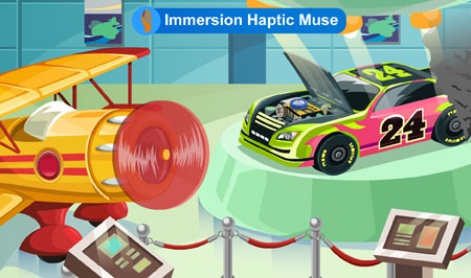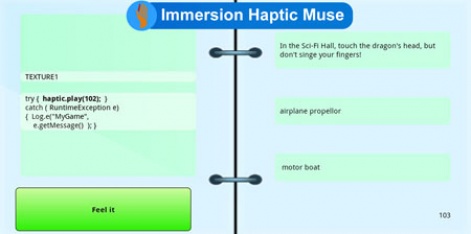The best way of teaching a new skill is by active demonstration.
That's the approach being taken by US haptics company Immersion.
It's been an expert in tactile feedback control and technology for 20 years, and has its IP in devices from OEMs ranging from Samsung and LG to Nokia and Sony.
So when it came to encouraging mobile game developers to take full advantage of its smarts on Android, it decided to lead by example.
It's just released its free Haptic Muse demonstration app, which contains 124 preset effects that are categorised in terms of their use in different game genres.
We caught up with director of marketing Mandi Mena to find out why it's taken this approach, and how it hopes it will encourage developers to be more creative when it comes to tactile feedback.
Pocket Gamer: Why did you decide to come up an demonstration app like Haptic Muse?
Mandi Mena: The Haptic Muse app was designed to inspire gamers by showing how compelling gameplay can be when the audio and visual design is enhanced with haptics.
Prior to the Haptic Muse app, Immersion had developed a more generic effect preview app that allowed developers to feel the library of tactile effects without any visual or audio.

While effect playback is a helpful tool, we knew that if we provided developers with an app that allowed them to see, hear and feel the effects in a gaming context, we would spark more creativity.
What were the challenges of developing an app like this?
We had a very typical set of challenges in the application design process. While we knew what we wanted to accomplish, we weren't quite sure how to go about it.
We spent many hours in brainstorm cycles, eventually determined the direction for the app and a design style, worked with external designers and developers, and of course, there was a bit of "management by committee" that hindered progress along the way.
But we can say with confidence that the integration of the haptic effects was the easiest part!
124 pre-sets seems like a lot of effects. How did you come up with them all and how different are they from each other?
Developers are normally surprised by how many distinctive effects can be created using the actuator motor technology that already exists in today's Android smartphones.
Immersion has been working in haptics for 20 years, and our experts have designed the effect library to create unique effects for different contexts.

If you think about it, there are so many different use cases for haptic effects, everything from button clicks and alerts, to advanced effects like distinctive feedback for weapons (think shotgun vs. machine gun), explosions or textures.
The effects are organised by type, so it's pretty easy for developers to find the right effect that works for their action sequence.
How do you hope Haptic Muse will change the way developers use your technology?
It was designed to get developers excited and thinking about how haptics can complement the audio and visual design of a game.
We've seen some of the top Android game developers, such as Sega, Rockstar Games and Handy Games use our technology to take their games to the next level, but it's still a relatively new design tool.
By developing the Haptic Muse app, we hope we can get the technology in more developers' hands and show them what is possible. And we hope everyone has a bit of fun in the discovery process.
More generally, what do you think are the biggest obstacles to developer using more haptics in their games?
I think the biggest obstacles are that developers don't realise the tools that are available to them.
Using standard vibrate function APIs normally allow you to turn a motor on and off with no nuanced control, which you need to create distinctive effects. And developers are limited in understanding how the commands will feel across different devices and motor types.

Immersion's tools are free for game developers, our SDK includes technology which detects and optimises the device actuator for the best possible haptic playback, and our effect set was designed by experts.
Once developers have access to the tools, we've seen great engagement and quick adoption. So our big job is to make sure developers are aware of the tools that make the integration and design of haptics painless.
You can get your hands on Haptic Muse from Google Play right here.





















